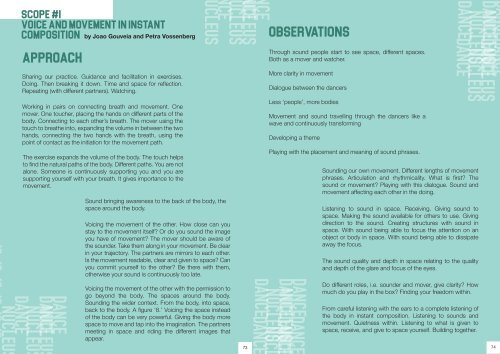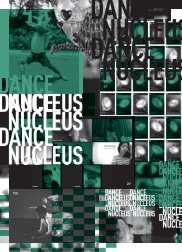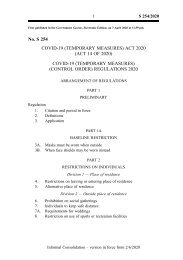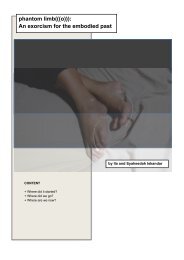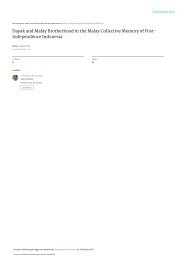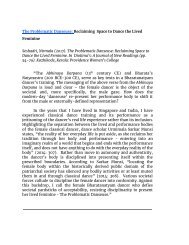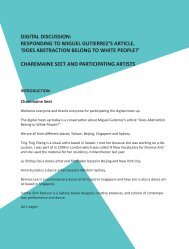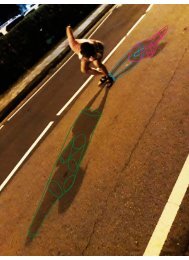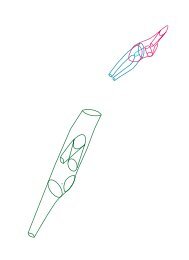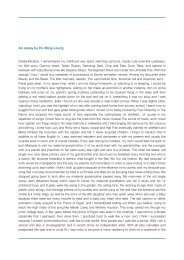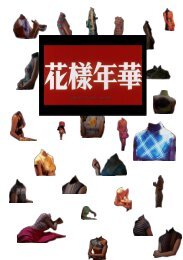FUSE#1
FUSE is a bi-annual publication that documents the projects at Dance Nucleus
FUSE is a bi-annual publication that documents the projects at Dance Nucleus
You also want an ePaper? Increase the reach of your titles
YUMPU automatically turns print PDFs into web optimized ePapers that Google loves.
Scope #1<br />
Voice and movement in instant<br />
composition<br />
Approach<br />
by Joao Gouveia and Petra Vossenberg<br />
Sharing our practice. Guidance and facilitation in exercises.<br />
Doing. Then breaking it down. Time and space for reflection.<br />
Repeating (with different partners). Watching.<br />
Working in pairs on connecting breath and movement. One<br />
mover. One toucher, placing the hands on different parts of the<br />
body. Connecting to each other’s breath. The mover using the<br />
touch to breathe into, expanding the volume in between the two<br />
hands, connecting the two hands with the breath, using the<br />
point of contact as the initiation for the movement path.<br />
The exercise expands the volume of the body. The touch helps<br />
to find the natural paths of the body. Different paths. You are not<br />
alone. Someone is continuously supporting you and you are<br />
supporting yourself with your breath. It gives importance to the<br />
movement.<br />
Sound bringing awareness to the back of the body, the<br />
space around the body.<br />
Voicing the movement of the other. How close can you<br />
stay to the movement itself? Or do you sound the image<br />
you have of movement? The mover should be aware of<br />
the sounder. Take them along in your movement. Be clear<br />
in your trajectory. The partners are mirrors to each other.<br />
Is the movement readable, clear and given to space? Can<br />
you commit yourself to the other? Be there with them,<br />
otherwise your sound is continuously too late.<br />
Voicing the movement of the other with the permission to<br />
go beyond the body. The spaces around the body.<br />
Sounding the wider context. From the body, into space,<br />
back to the body. A figure ‘8.’ Voicing the space instead<br />
of the body can be very powerful. Giving the body more<br />
space to move and tap into the imagination. The partners<br />
meeting in space and riding the different images that<br />
appear.<br />
Observations<br />
Through sound people start to see space, different spaces.<br />
Both as a mover and watcher.<br />
More clarity in movement<br />
Dialogue between the dancers<br />
Less ‘people’, more bodies<br />
Movement and sound travelling through the dancers like a<br />
wave and continuously transforming<br />
Developing a theme<br />
Playing with the placement and meaning of sound phrases.<br />
Sounding our own movement. Different lengths of movement<br />
phrases. Articulation and rhythmicality. What is first? The<br />
sound or movement? Playing with this dialogue. Sound and<br />
movement affecting each other in the doing.<br />
Listening to sound in space. Receiving. Giving sound to<br />
space. Making the sound available for others to use. Giving<br />
direction to the sound. Creating structures with sound in<br />
space. With sound being able to focus the attention on an<br />
object or body in space. With sound being able to dissipate<br />
away the focus.<br />
The sound quality and depth in space relating to the quality<br />
and depth of the glare and focus of the eyes.<br />
Do different roles, i.e. sounder and mover, give clarity? How<br />
much do you play in the box? Finding your freedom within.<br />
From careful listening with the ears to a complete listening of<br />
the body in instant composition. Listening to sounds and<br />
movement. Quietness within. Listening to what is given to<br />
space, receive, and give to space yourself. Building together.<br />
73 74


